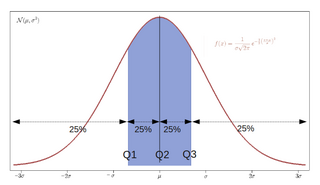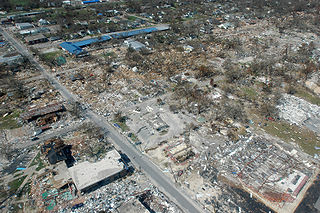In finance, the net present value (NPV) or net present worth (NPW) is the summation of the present (now) value of a series of present and future cash flows. Because NPV accounts for the time value of money NPV provides a method for evaluating and comparing products with cash flows spread over many years, as in loans, investments, payouts from insurance contracts plus many other applications.
Financial economics is the branch of economics characterized by a "concentration on monetary activities", in which "money of one type or another is likely to appear on both sides of a trade". Its concern is thus the interrelation of financial variables, such as prices, interest rates and shares, as opposed to those concerning the real economy. It has two main areas of focus: asset pricing and corporate finance; the first being the perspective of providers of capital, i.e. investors, and the second of users of capital.
The Black–Scholes or Black–Scholes–Merton model is a mathematical model for the dynamics of a financial market containing derivative investment instruments. From the partial differential equation in the model, known as the Black–Scholes equation, one can deduce the Black–Scholes formula, which gives a theoretical estimate of the price of European-style options and shows that the option has a unique price regardless of the risk of the security and its expected return. The formula led to a boom in options trading and provided mathematical legitimacy to the activities of the Chicago Board Options Exchange and other options markets around the world. It is widely used, although often with adjustments and corrections, by options market participants.
Market risk is the risk of losses in positions arising from movements in market prices.:
Survival analysis is a branch of statistics for analyzing the expected duration of time until one or more events happen, such as death in biological organisms and failure in mechanical systems. This topic is called reliability theory or reliability analysis in engineering, duration analysis or duration modelling in economics, and event history analysis in sociology. Survival analysis attempts to answer questions such as: what is the proportion of a population which will survive past a certain time? Of those that survive, at what rate will they die or fail? Can multiple causes of death or failure be taken into account? How do particular circumstances or characteristics increase or decrease the probability of survival?
In mathematical optimization, statistics, econometrics, decision theory, machine learning and computational neuroscience, a loss function or cost function is a function that maps an event or values of one or more variables onto a real number intuitively representing some "cost" associated with the event. An optimization problem seeks to minimize a loss function. An objective function is either a loss function or its negative, in which case it is to be maximized.
In finance, systemic risk is the risk of collapse of an entire financial system or entire market, as opposed to risk associated with any one individual entity, group or component of a system, that can be contained therein without harming the entire system. It can be defined as "financial system instability, potentially catastrophic, caused or exacerbated by idiosyncratic events or conditions in financial intermediaries". It refers to the risks imposed by interlinkages and interdependencies in a system or market, where the failure of a single entity or cluster of entities can cause a cascading failure, which could potentially bankrupt or bring down the entire system or market. It is also sometimes erroneously referred to as "systematic risk".
Liquidity risk is a financial risk that for a certain period of time a given financial asset, security or commodity cannot be traded quickly enough in the market without impacting the market price.
In finance, leverage is any technique involving the use of debt rather than fresh equity in the purchase of an asset, with the expectation that the after-tax profit to equity holders from the transaction will exceed the borrowing cost, frequently by several multiples, hence the effect of a lever or gear in physics, where a small force is enabled to produce a much larger reaction. Normally, the lender will set a limit on how much risk it is prepared to take and will set a limit on how much leverage it will permit, and would require the acquired asset to be provided as collateral security for the loan. For example, for a residential property the finance provider may lend up to, say, 80% of the property's market value, for a commercial property it may be 70%, while on shares it may lend up to, say, 60% or none at all on certain volatile shares.
Financial risk management is the practice of economic value in a firm by using financial instruments to manage exposure to risk: operational risk, credit risk and market risk, foreign exchange risk, shape risk, volatility risk, liquidity risk, inflation risk, business risk, legal risk, reputational risk, sector risk etc. Similar to general risk management, financial risk management requires identifying its sources, measuring it, and plans to address them.
In the fields of actuarial science and financial economics there are a number of ways that risk can be defined; to clarify the concept theoreticians have described a number of properties that a risk measure might or might not have. A coherent risk measure is a function that satisfies properties of monotonicity, sub-additivity, homogeneity, and translational invariance.
The RiskMetrics variance model was first established in 1989, when Sir Dennis Weatherstone, the new chairman of J.P. Morgan, asked for a daily report measuring and explaining the risks of his firm. Nearly four years later in 1992, J.P. Morgan launched the RiskMetrics methodology to the marketplace, making the substantive research and analysis that satisfied Sir Dennis Weatherstone's request freely available to all market participants.
Credit analysis is the method by which one calculates the creditworthiness of a business or organization. In other words, It is the evaluation of the ability of a company to honor its financial obligations. The audited financial statements of a large company might be analyzed when it issues or has issued bonds. Or, a bank may analyze the financial statements of a small business before making or renewing a commercial loan. The term refers to either case, whether the business is large or small.
Asset/liability modelling is defined as the process used to manage the business and financial objectives of a financial institution or an individual through an assessment of the portfolio assets and liabilities in an integrated manner. The process is characterized by an on-going review, modification, and revision of asset liability management strategies so that sensitivity to interest rate changes are confined within acceptable tolerance levels. There are different models used and some use different elements, according to specific needs and contexts. For instance, an individual or an organization may keep parts of the ALM process and outsource the modeling function or adapt the model according to the requirements and capabilities of relevant institutions such as banks, which often have their in-house modeling process. For pensioners, asset/liability modeling is all about determining the best allocation for specific situations. There is a vast array of models available today for practical asset and liability modeling and these have been the subject of several research and studies.
Mathematical finance, also known as quantitative finance, is a field of applied mathematics, concerned with mathematical modeling of financial markets. Generally, mathematical finance will derive and extend the mathematical or numerical models without necessarily establishing a link to financial theory, taking observed market prices as input. Mathematical consistency is required, not compatibility with economic theory. Thus, for example, while a financial economist might study the structural reasons why a company may have a certain share price, a financial mathematician may take the share price as a given, and attempt to use stochastic calculus to obtain the corresponding value of derivatives of the stock. The fundamental theorem of arbitrage-free pricing is one of the key theorems in mathematical finance, while the Black–Scholes equation and formula are amongst the key results.

Corporate finance is an area of finance that deals with sources of funding, the capital structure of corporations, the actions that managers take to increase the value of the firm to the shareholders, and the tools and analysis used to allocate financial resources. The primary goal of corporate finance is to maximize or increase shareholder value. Although it is in principle different from managerial finance which studies the financial management of all firms, rather than corporations alone, the main concepts in the study of corporate finance are applicable to the financial problems of all kinds of firms.
Time at Risk (TaR) is a time-based risk measure designed for corporate finance practice.



